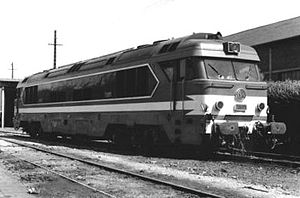SNCF CC 70000
| SNCF CC 70000 | |
|---|---|
|
CC 70001
|
|
| Numbering: | 70001-70002 |
| Number: | 2 |
| Manufacturer: |
Alsthom Chantiers de l'Atlantique |
| Year of construction (s): | 1965-1966 |
| Retirement: | until 1983 |
| Axis formula : | C'C ' |
| Gauge : | 1435 mm ( standard gauge ) |
| Length over buffers: | 22,730 mm |
| Bogie axle base: | 3,216 mm |
| Total wheelbase: | 15,916 mm |
| Service mass: | 117 t |
| Friction mass: | 117 t |
| Wheel set mass : | 19.5 t |
| Top speed: | 85 km / h / 140 km / h |
| Installed capacity: | 2 × 1,766 kW (2 × 2,400 PS) |
| Wheel diameter: | 1,050 mm |
| Motor type: | SEMT Pielstick 16PA4 185 |
| Motor type: | 2 × 16 cylinder four-stroke diesel engine |
| Power transmission: | electrical (mixed current) |
| Number of traction motors: | 2 × TAO 656 A |
| Drive: | Single motor bogie |
| Brake: |
indirect air brake direct air brake hand brake |
| Train control : | SNCF |
| Train heating: | electric |
| Coupling type: | UIC screw coupling |
The diesel-electric locomotives of the CC 70000 series were built from 1965 to 1966 for the French state railway SNCF . Together with the BB 69000 , they were test locomotives to replace the most powerful steam locomotives of the SNCF around 1966. In contrast to the already existing diesel locomotives , these machines had two drive motors, in contrast to the BB 69000 , a diesel-electric power transmission was used again. Both locomotives were retired by 1983 and scrapped in the late 1980s. A locomotive bogie has been preserved in the Mulhouse Railway Museum.
At 22.73 m, the machines were the longest diesel locomotives of the SNCF. The design came from Paul Arzens , the driver's cabs corresponded to those of the BB 67000 series .
History and description
In parallel to the development work for the BB 67000 and A1A A1A 68000 with just one machine system, the SNCF had a locomotive with two machine systems developed and two model locomotives built for test purposes at Alsthom and Chantiers de l'Atlantique . The power of the locomotive was an impressive 4800 hp. Although the vehicles had the same engine type as the BB 69000, the CC 70000 had full power. The contract for the development and manufacture of the locomotives was assigned to the Alsthom company. The first locomotive was delivered in 1965, the second followed a year later.
Thought the locomotives for the transport of the heaviest trains on driving routes without to steam engines, especially those were SNCF 241 P to replace. After scheduled and unscheduled stops, they should have the same accelerations as electric locomotives . Since the locomotives had many technical innovations, an extensive test program was set up with them. In contrast to the BB 69000, two three-axle bogies were required due to the weight of the diesel-electric drive system . The axle drives were implemented with mono-motor bogies in the same way as the CC 40100 . The gearboxes had two ranges with a top speed of 85 km / h and 140 km / h, which could be switched when the vehicle was stationary. The locomotives were therefore suitable for transporting heavy express and freight trains. With the CC 70002 , a possibility of switching while driving was tested.
Otherwise, the machine system was innovative. The two diesel engines were positioned opposite one another with their output side in the middle of the locomotive. A main generator for alternating current was used in the diesel-electric drive system . Each diesel engine drove a rotor part of the main generator via a flexible Geislinger coupling . Both rotor parts turned in opposite directions around an axis. Since the diesel engines ran at a speed of 1,500 rpm in the rated load range, the generator speed was 3,000 rpm. The front diesel engine drove the outer rotor part, the stator part, while the rear diesel engine drove the part with the field windings . The alternating voltage induced by the generator was then rectified via a Graetz circuit and fed to the two frame motors in the bogie.
After delivery, the locomotives were tested for several years from 1965 and were based in Chalindrey . Instead of the locomotives with two drive systems and innovative power generation, the CC 72000 with a simpler drive system were put into series production for the area of responsibility from 1972 . The CC 70000 , like the two BB 69000, continued to be used for freight train service. The CC 70000 is said to have been less reliable than the BB 69000 . The electrical equipment was unreliable and the bogies of the CC 70002 , which could be switched while driving , did not work properly. The one machine system of the CC 72000 was the decisive advantage over the CC 70000 . The beginning of the oil price crisis was the decisive reason to take the locomotives out of service. Due to the high maintenance costs , the locomotives were retired until 1983, after the CC 70002 was retired in 1973 after an accident. Both locomotives were scrapped in the late 1980s.
literature
- Wolfgang Glatte, Lothar Reinhardt: Diesel Locomotive Archive , Transpress-Verlag, Berlin 1970
Web links
- Website about the career and technology of the BB 70000
- Film about the production and operation of the CC 70000
- Photo of a train with leading CC 70000
